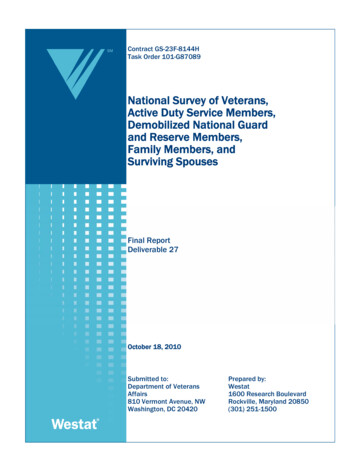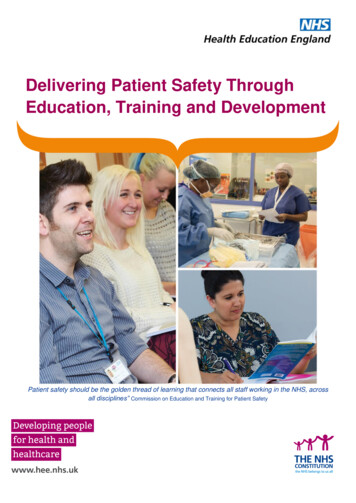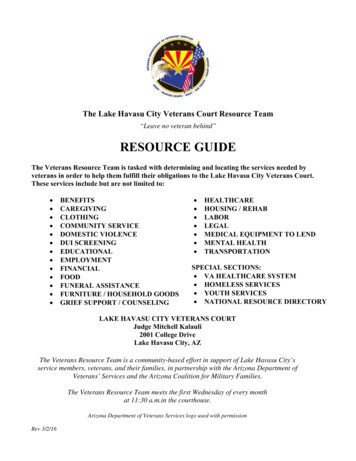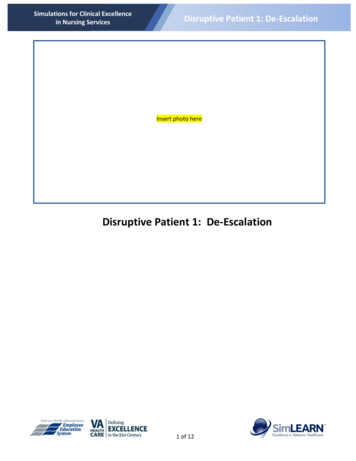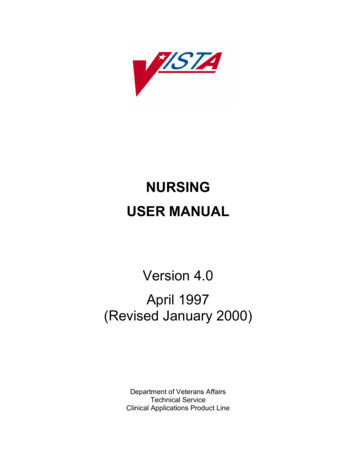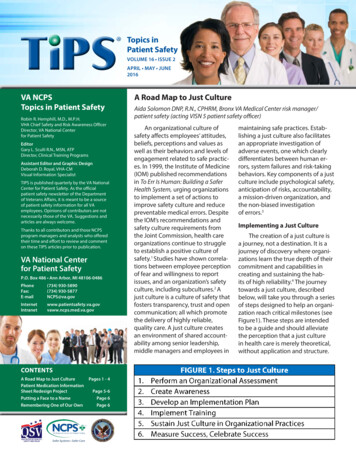
Transcription
Topics in Patient Safety VOLUME 16 ISSUE 1 Topics inPatient SafetyVOLUME 16 ISSUE 2APRIL MAY JUNE2016VA NCPSTopics in Patient SafetyRobin R. Hemphill, M.D., M.P.H.VHA Chief Safety and Risk Awareness OfficerDirector, VA National Centerfor Patient SafetyEditorGary L. Sculli R.N., MSN, ATPDirector, Clinical Training ProgramsAssistant Editor and Graphic DesignDeborah D. Royal, VHA-CMVisual Information SpecialistTIPS is published quarterly by the VA NationalCenter for Patient Safety. As the officialpatient safety newsletter of the Departmentof Veterans Affairs, it is meant to be a sourceof patient safety information for all VAemployees. Opinions of contributors are notnecessarily those of the VA. Suggestions andarticles are always welcome.Thanks to all contributors and those NCPSprogram managers and analysts who offeredtheir time and effort to review and commenton these TIPS articles prior to publication.VA National Centerfor Patient SafetyP.O. Box 486 Ann Arbor, MI 48106-0486PhoneFax:E-mail(734) 930-5890(734) ty.va.govvaww.ncps.med.va.govCONTENTSA Road Map to Just CulturePatient Medication InformationSheet Redesign ProjectPutting a Face to a NameRemembering One of Our OwnPages 1 - 4Page 5-6Page 6Page 6A Road Map to Just CultureAida Solomon DNP, R.N., CPHRM, Bronx VA Medical Center risk manager/patient safety (acting VISN 5 patient safety officer)An organizational culture ofsafety affects employees’ attitudes,beliefs, perceptions and values aswell as their behaviors and levels ofengagement related to safe practices. In 1999, the Institute of Medicine(IOM) published recommendationsin To Err Is Human: Building a SaferHealth System, urging organizationsto implement a set of actions toimprove safety culture and reducepreventable medical errors. Despitethe IOM’s recommendations andsafety culture requirements fromthe Joint Commission, health careorganizations continue to struggleto establish a positive culture ofsafety.1 Studies have shown correlations between employee perceptionof fear and willingness to reportissues, and an organization’s safetyculture, including subcultures.2 Ajust culture is a culture of safety thatfosters transparency, trust and opencommunication; all which promotethe delivery of highly reliable,quality care. A just culture createsan environment of shared accountability among senior leadership,middle managers and employees inmaintaining safe practices. Establishing a just culture also facilitatesan appropriate investigation ofadverse events, one which clearlydifferentiates between human errors, system failures and risk-takingbehaviors. Key components of a justculture include psychological safety,anticipation of risks, accountability,a mission-driven organization, andthe non-biased investigationof errors.3Implementing a Just CultureThe creation of a just culture isa journey, not a destination. It is ajourney of discovery where organizations learn the true depth of theircommitment and capabilities increating and sustaining the habits of high reliability.4 The journeytowards a just culture, describedbelow, will take you through a seriesof steps designed to help an organization reach critical milestones (seeFigure1). These steps are intendedto be a guide and should alleviatethe perception that a just culturein health care is merely theoretical,without application and structure.
Topics in Patient Safety VOLUME 16 ISSUE 2PAGE 2The just culture journey is a relevantand practical one that can betailored to each organization’s visionand goals.Define Vision and GoalsStart the just culture journey byclearly defining your organization’svision and goals. Culture changeis a top-down approach requiringtime and commitment to unravelunhealthy behaviors and re-establisha path forward driven by the statedmission, beliefs and values of theorganization.5 Therefore, just cultureimplementation requires a conscious,visible commitment and strongsupport from senior leadership. Justculture implementation also needsa team of motivated and passionateemployees who are going to movethe initiative along. The team shouldbe comprised of senior leadership(sponsor), a human resourcerepresentative, physician and nursechampions, middle managers,education staff, administrativestaff, and union representatives.From the outset it is important todesignate who will be the driver(leader) of the implementation teamand its efforts. It is vital that seniorleadership and all team membersenter this journey with an adequatebaseline knowledge of just cultureconcepts. As well, a clearly definedmission statement and goals specificto the just culture initiative shouldbe written into the organization’sexisting strategic plan, and shouldaddress senior leadership’s vision ofthe organization’s safety culture inthree to five years from starting thejourney. At the Bronx VA MedicalCenter, the mission statement is:To create an environment oftrust and shared accountabilityin which employees feel safe andare encouraged to report safetyrelated information. Employeestrust that they will not be heldaccountable for system failures;but, also take accountability fortheir behavioral choices.Perform an OrganizationalAssessmentAn organization cannot travel toa new place unless it knows where itcurrently resides. To this end, performing an organizational assessment will provide a gap analysis andbaseline data which can be used toidentify improvement targets. The assessment can be accomplished via informal and honest input garnered bythe implementation team, past culture surveys, and an analysis of system safety practices and processes.There are four main concepts associated with a just culture (see Figure2). These concepts comprise whatshould be referred to as the “just culture bundle,” as they are all essentialfor successful implementation.6 It isprudent to assess your organization’scurrent status and readiness undereach bundle element as this will helpthe team prioritize and set specificobjectives along with measureableoutcomes to address the gaps. Thisorganizational assessment should beviewed as a framework for building ajust culture and a method to understand current safety practices, onlychanging processes as needed, andnot as a separate initiative.Create AwarenessRaising awareness throughoutthe organization at the beginningof the just culture journey will helpemployees stay engaged, provideopportunity for open dialogue, andhelp with the sustainability of thecultural transformation. A strongmessage should be developed thatincludes the organization’s just culture definition and mission, reasonfor adapting a just culture model,and the roles and responsibilities ofemployees. There are several methods and venues available for dissemination including all staff commu-
Topics in Patient Safety VOLUME 16 ISSUE 2nication campaigns, patient safetyactivities, committee meetings, staffmeetings, town halls, intranet postings, and printed materials to informand engage staff at all levels. Awareness creates opportunities to gainstaff feedback and enlightenmenton potential barriers to implementation. In order to produce sustainablecultural change, employees must feelincluded, supported and empoweredto adapt the just culture model.Develop an Implementation PlanThe implementation plan shouldinclude developing a staff educationprogram along with a clear and usable just culture-decision algorithm.In a just culture, it is imperative toutilize a consistent, fair, objective,and human factors-based process toinvestigate errors and decide whatthe organizational response will be.This avoids a singular focus on individual acts and the hasty assignmentof blame.7 An objective process alsoavoids severity bias (which has noplace in a just culture), where leadersand managers react to an incidentbased on the severity of patientharm rather than the intent of thoseinvolved. There are several publishedalgorithms that aid in identifyinghuman error, at-risk behavior, reckless behavior, and/or system failuresassociated with adverse events.3,8,9The just culture principle is based onidentifying these behaviors and initiating an appropriate organizationalresponse such as: consoling humanerrors, coaching at-risk behaviors,and punitive actions for reckless ormalicious behaviors. Senior leadership input must be consideredwhen either choosing an existingdecision algorithm or creating a newone. Leaders must set the tone andoutline what behaviors are acceptable and unacceptable, being carefulto avoid defaulting to punishmentwhen significant patient injuryoccurs. The Bronx VA Medical Centerjust culture algorithm guides managers and employees through seveninvestigative categories/steps: Individual’s intent Equipment failure Peer action of similar experience Training issues Competency evaluation Individual risk awareness System barriersUsing the organization’s needsassessment conducted earlier in theprocess, the implementation teamalong with staff education personnelmust develop an education plan andobjectives. Planning for interactiveand multimodal workshops is recommended to promote adult learningand staff participation. The workshops provide staff with the theory tounderstand just culture concepts andthe tools to apply these concepts intheir daily practice.Implement TrainingJust culture training must beprovided to senior leadership, middlemanagement and staff in all services.It should be incorporated in newemployee orientation, new supervisor/manager orientation, ongoingstaff and manager education, resident education, and all elements ofemployee training. It is important forsenior leadership to be visible duringthe training process and providerecognition to services or units thatare actively engaged in the justculture education process. The BronxVA Medical Center found success inproviding individual service-leveltraining by bringing the training tothe unit or place of work. It was alsohelpful to train staff separately frommanagers and leaders to allow forbetter staff engagement and a moreopen and honest dialogue duringthe sessions.PAGE 3Build and Sustain Just Culture inOrganization PracticesBuilding policies and processesthat support the just culture modeltakes time. This can be accomplishedby taking small steps towards aligning processes and policy languagewith just culture principals. Thesemay include human resource policiesthat are heavily based on counseling and reprimanding employeesversus coaching when appropriate;or patient safety policies that don’tdefine what risk-taking behaviors areand how to manage them. As organizations begin to create, promote andadhere to a just culture frameworkin daily practice, staff will becomemore mindful and decrease risk-taking behaviors over time.10 The BronxVA Medical Center has incorporatedthe just culture model in the incident review process. As an example,when an incident occurs involvingthe mislabeling of a specimen, themanager reviews the incident objectively using the just culture algorithmto identify any system failures, at-riskbehaviors and/or reckless behaviors. This affords the organizationan opportunity to identify systemissues while simultaneously allowingmanagers the latitude to engage indiscussion and coaching of employees. Currently, the Bronx VA MedicalCenter is in the process of incorporating just culture principals intoexisting policies.Measure and Celebrate SuccessIt is important to measure process as well as outcomes along thejust culture journey. In the organizational assessment stage measurableobjectives are developed which canbe reprioritized during the differentstages of implementation. Key measures should include staff perceptionof safety along with incident andnear-miss reporting trends. Celebrating milestones of success will em-
Topics in Patient Safety VOLUME 16 ISSUE 2power staff to continue to embraceculture change.Looking ForwardThe just culture model has thepotential for becoming the goldstandard in providing a frameworkfor patient safety. Just culture implementation requires senior leadershipto model and communicate safety asa top priority; and promote organizational learning to reduce errorsand increase risk awareness.11, 12 Overtime staff attitudes about reporting,and the need to partner with leadership in the name of safety, willimprove. With strong commitmentfrom all levels in the organization,and shared values across services,the just culture journey will continue, moving all towards the goal of asafer system.References1. Kohn, K. T., Corrigan, J. M. andDonaldson, M. S. (2000). To erris human: Building a safer healthsystem, Washington, DC: National Academy Press.2. Sirriyeh, R., Lawton, R., Armitage,G., Gardner, P., and Ferguson,S. (2012). Safety subcultures inhealth care organizations andmanaging medical error. HealthServices Management Research, 25(1), 16-23. doi:10.1258/hsmr.2011.0110183. Marx, D. (2001). Patient safetyand the “just culture”. A primer for health care executives.Retrieved from: /ahrq/FinalPrimerDoc.pdf4. Frankel, A. S., Leonard, M. W.,and Denham, C. R. (2006). Fairand just culture, team behavior,and leadership engagement.The tools to achieve high reliability. Health Services Research,41(2), 1690-1709. doi:10.1111/j.1475-6773.2006.00572 (7)5. Sheard, D. (2014). Achievingculture change: a whole organization approach. Nursing andResidential Care, 16 (6), 329-332.6. Khatri, N., Brown, G. D., andHicks, L. L. (2009). From a blameculture to a just culture in healthcare. Health Care Manager Review, 34(4), 312-322. doi:10.1097/hmr.0b013e3181a3b7097. Gorini, A., Miglioretti, M., andPravettoni, G. (2012). A newperspective on blame culture:An experimental study. Journalof Evaluation in Clinical Practice,18(3), 671-675. doi:10.1111/j.1365-2753.2012.01831.x8. (4)8. Meadows, S., Baker, K., andButler, J. (2005). The incidentdecision tree: Guidelines foraction following patient safetyincidents. Retrieved from: -in-patient-safety/vol4/Meadows.pdf9. Peltomaa, K. (2012). JamesReason: Patient safety, humanPAGE 4error, and Swiss cheese. QualityManagement in Health Care,21(1), 59-63. doi:10.1097/qmh.0b013e318241829410. Weaver, S., J., Lubomksi, L. H.,Wilson, R. F., Pfoh, E. R., Martinez,K. A., Dy, S. M. (2013). Promotinga culture of safety as a patientsafety strategy: A systematicreview. Annals of InternalMedicine, 158(5), 11. Rideout, D. (2013). ‘Just culture’encourages error reporting,improves patient safety. ORManager, 29(7), 13-15. Retrievedfrom: http://ezp.waldenulibrary.org/login?url http://search.ebscohost.com/login.aspx?direct trueanddb rzhandAN 2012167903andscope site12. Westphal, J. (2009). Basicconcepts of a Just culture.Federation Forum. Retrievedfrom: https://www.fsbpt.org/download/Forum Winter09JustCulture.pdfVA NCPS Launches New ProgramIn the next issue, NCPS willformally present “My VoiceMatters,” a comprehensiveprogram encompassing multipleelements that, if implementedfully, will enable your facility tocreate and sustain a just andfair culture. A highlight of theprogram is the Just CultureSeminar for Leaders. The seminarsare presented by NCPS to top-,mid- and service line-levelleaders. Materials and tools areshared completely with facilitiesfor dissemination to the front line.
Topics in Patient Safety VOLUME 16 ISSUE 2PAGE 5Patient Medication Information Sheet Redesign Project:A Patient Safety Initiative Identified by the Patient-Centered Prescription Label StudyBy Tim Arnold, PharmD and Keith W. Trettin R.Ph., MBA, VA National Center for Patient SafetyPatient-Centric Prescription Labelexpert advisory panel guided the initial label redesign.Participants’ ability to comprehend prescription labelinformation was assessedand their preferences withregard to spatial organization were collected. Theresults of this study guidedthe format of a redesignedlabel for piloting at VA medtration and its partners.2 The studyical centers. In 2012, VISNsaims to determine the impact of PMI6, 7, 8 and the Charleston Centraltypography, format, and contentMail Order Pharmacy (CMOP) wereselection on preference and comselected as pilot sites to trial theprehensionin Veterans. To ensure annew label. After completion of theadequateculturaland geographicaltrial, the patient-centric label wassampling,evaluationsare beingauthorized by the VISN pharmacyconductedatsiteswherethe paexecutives and subsequently adtient-centriclabelstudywasalso caropted as the standard VA-wide. Theried out. Currently half-way throughCMOPS are currently in the processthe data-collection phase, studyof implementing the label and VAcompletion is scheduled for the endmedical center implementation isof calendar year 2016. The results ofnow complete.this initiative will be instrumentalThe next phase of this effortaddresses the redesign of the Patient to the decision-making processes,Medication Information (PMI) sheets. influencing future PMI design and1) Prescription label formatimplementation efforts.The PMI sheets, provided by VA and2) Patient instruction wordThis is a story of the initiativesupplied with each prescription,selectionandvision that ultimately led to aprovide Veterans with importantnationalcollaborative to redesigndrug information, such as indica3) Patient medication informationandstandardizethe pharmacytions, side effects, precautions, andsheet formatprescription label and PMI withindrug interactions. The current PMIIn 2011, the patient-centric prethe VA system. Through a disciplinedscription label study was conducted; sheet was examined using severalreadability evaluation methods, and project management approach,this included the participation ofit was found that its content requires and the support of Veterans andover 400 Veterans representing 11VA personnel, the effort to create aVA care sites and over 600 pharmacy a high-school education to compresafer medication delivery system byhend. In addition, the typographystaff.1 Recommendations from animproving Veteran comprehensionand format of the PMI influenceslegibility and readability, of of prescription related information,Example of an Old Prescription Labelhas become a reality.particular concern to theFor more information on thevisually impaired, whichpatient-centriclabel project, VA emdirectly affects compreployeescangoto https://vaww.cmohension and motivation topnational.va.gov/cmop/PBM/Preread. In this study, the PMIscription%20Labels%20Patient%20sheets were redesignedCentric/Forms/AllItems.aspxusing principles similar tothose described by the U.S.Food and Drug AdminisThe patient-centric prescriptionlabel and medication information redesign movement is a collaborativeeffort between the VA National Center for Patient Safety (NCPS), Pharmacy Benefits Management (PBM),Patient Safety Managers (PSMs),and VA pharmacists. Minimizationof medication errors and standardization of the data elements on theprescription label and medication information sheets are the goals of thisredesign effort. In 2010, NCPS andthe PBM joined forces to conduct astudy testing suspicions that currentprescription label formatting madeVeteran comprehension of druginformation and instructions difficult. It was anticipated that the studywould also provide key insights intothe reformatting of prescriptionlabel information, and the redesignof the outpatient pharmacy prescription label. This effort identified andconfirmed three areas in need offurther exploration:
Topics in Patient Safety VOLUME 16 ISSUE 2References1. Trettin, K., Narus, E. (2013).Implementation of a VA Patientcentered Prescription Label.Advances in Human Aspects ofHealthcare, CRC Press, 429-437.PAGE 6Putting a Face to a Name: Your Patient Safety Team2. Kish-Doto, J., Scales, M., EguinoMedina, P., Fitzgerald, T., Tzeng, J.P., McCormack, L. A., and West, S.L. (2014). Preferences for patientmedication information: what dopatients want?. Journal of healthcommunication, 19(sup2), 77-88.3. Murphy, J. (2010). How a localpatient safety initiative isbecoming a national priority. VANational Center for Patient SafetyTIPS Newsletter. 10(5), 2-3.Elizabeth Vinton, BSN, R.N.Patient Safety ManagerAsheville, North CarolinaFive and one half yearsFlorence Kocher, DNP, MSN, R.N.Patient Safety Manager Philadelphia VATwo and one half yearsPeter Leporati, MS, BSN, R.N.Patient Safety Manager Philadelphia VAFive years total (three years as patient safetymanager)James B. “J.B.” McGuire RRT, MPA,CPHQVISN 8 Patient Safety OfficerEight yearsRemembering One of Our Own, “Gertie” GibsonREMEMBERING A TRUSTED FRIEND TO PATIENT SAFETY
To Err Is Human: Building a Safer Health System, urging organizations to implement a set of actions to improve safety culture and reduce preventable medical errors. Despite the IOM's recommendations and safety culture requirements from the Joint Commission, health care organizations continue to struggle to establish a positive culture of .
